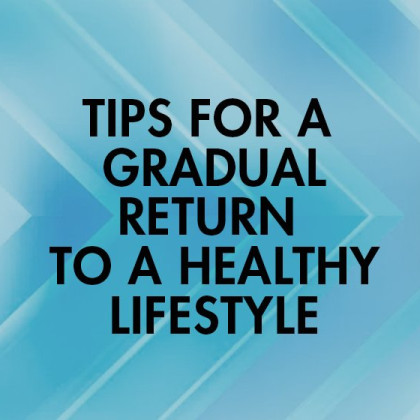Tips for a Gradual Return to a Healthy Lifestyle

As the COVID-19 era set in back in March, gyms shut down, food and supplies became sparse, grocery stores became scary, routines got flipped upside down, the snow continued to fall outside, and families got uprooted. People across the world began living in ways that were new to them, often throwing them off their traditional paths and disabling equilibrium. We’ve all heard college students talk about “The Freshman Fifteen,” or, “The Sophomore Sixteen,” but what about “The COVID Nineteen?”
With new routines, added stress, and more to do with less time and less accessibility, individuals have begun struggling in new ways. Some discuss unwanted weight gain due to eating more unhealthily or not being able to go to the gym, others discuss unwanted weight loss due to depression, anxiety, mental illness, stress, and malnutrition. Some people find themselves with constant headaches from viewing screens all day or not drinking enough water, while others find it difficult to stick to a nutrition schedule as their snacking habits are disproportionate to their typical mealtimes. No matter where you fall along this continuum of interrupted health habits, you’re not alone. There’s a whole community out there of people facing similar struggles as you, and the world as a whole is trying to regain that equilibrium again.
Something to keep in mind during this time is that not everything can or will be fixed all at once. With gyms reopening and the weather remaining nice, there may be this intense internal pressure to workout and lose that “COVID Nineteen” before having to fit back into your old work pants or blouses. There may also be the pressure of cooking healthier meals, snacking less, drinking more water, logging off electronics at a reasonable hour, sleeping more regularly, and regaining a sense of normalcy in various areas all at once. This is unreasonable and unsustainable. Choose one area to work on each week, and create new habits gradually rather than all at once. Overwhelming yourself in the beginning by trying to change every aspect of your health will usually lead to burnout and feeling like you’ve failed when not everything goes how you planned. Schedule your improvements into a realistic timeline, and view them as just that: improvements, not items on a checklist that you have to fix.
Here are a few quick tips to getting back on track:
- When possible, situate your at-home workstation in an area of your house where you are further away from the kitchen so you are not constantly staring at the fridge or pantry.
- Create a color-coded, large-scale calendar to hang in your house to keep you on track, accountable, and on a schedule that makes sense for your lifestyle.
- Plan meals ahead of time by making grocery lists and trips, including healthy snack choices, to cut down on eating unhealthy and typically more convenient foods that you have in your home.
- Set timers to prompt your water consumption. Every 20 minutes or so, set a timer or reminder to take a few more sips of water. That way, your body gets into a habit of craving and consuming water all day long.
- Take mini walks whenever possible. Even if it’s just to the mailbox and back, get up and stretch your legs. Get your steps in. Track them on your Smartphone or Smartwatch. You don’t have to hit a 10,000 steps goal, but set personal goals and try to exceed the day before whenever possible. Make it into a fun game!
- Put the scale away, or limit yourself to weigh-ins once or twice a week. Numbers don’t always signify health and wellness. It’s more about how you feel than the number on the scale.
Health, wellness, and mental well-being are all extremely important, but you can’t have it all if the process just adds to your stress levels. Wellness is a journey, and just like your equilibrium wasn’t thrown off in just one day, recovery won’t happen in just one day either. Be kind to yourself, allow yourself to plateau, and remember that life is rarely ever a linear battle.
____________________________________________
Bri Anderson has worked for ICAN for the last three years evolving through several roles in the company, including intern, support staff, supervised visitation monitor, adult care coordinator, and assisting staff in the marketing, quality assurance, and accounting departments. Bri has recently graduated with her Master of Social Work (MSW) degree from the University at Buffalo, and she hopes to continue her work with ICAN in a therapeutic capacity.